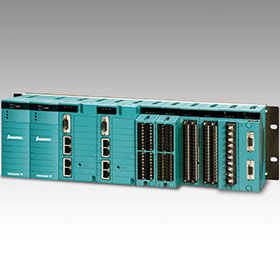

Yokogawa has announced that it will release an enhanced version of the Stardom network-based control system in the spring of 2016 that includes a newly developed high-speed CPU module for the FCN autonomous controller. Based on the concept of putting forward a product that is faster, stronger, smarter, Stardom will feature the new CPU module, improved environmental resistance, and an enhanced engineering tool. With this product, Yokogawa intends to expand the open network control system business.
Stardom is a network-based production control system that consists of the FCN autonomous controller and the VDS or Fast/Tools scada software. Since introducing this system in 2001, Yokogawa has continued to enhance it by adding new functions to satisfy customers’ needs. Combining the reliability of a distributed control system (DCS) with the versatility and economy of a programmable logic controller (PLC), the system is widely used in medium-size manufacturing plants and in geographically distributed applications such as natural oil and gas wells. To date, more than 20 000 systems have been delivered.
Stardom’s FCN autonomous controller will be capable of reliably controlling high-speed equipment such as compressors, large wind power generators, and other types of turbines, and will be able to operate in a wider range of climatic conditions. Moreover, it will include a function that aids engineers in the performance of installation, modification, and maintenance tasks.
Product features
High-speed calculation and communication
The processor in the FCN autonomous controller’s CPU module will have five times the processing speed of the processor used in the current CPU module. It will also have a Gigabit Ethernet port for faster communication. This will enable the FCN to control high-speed equipment such as compressors and turbines. With its improved capabilities, the FCN will also be able to control more advanced and complex applications. The new CPU module will have a total of four Ethernet ports, facilitating a greater number of connections and the configuration of redundant communication paths with scada systems.
With redundant CPUs and 120 PID control loops, the average processing speed for each loop will be about 0,2 ms (not including signal processing time). PID control is a feedback control technology that is widely used in basic materials industries such as oil, gas, and petrochemicals. For each loop, temperature, pressure, flow rate, and other process data from sensors and other types of detection devices are controlled based on a specified set-point, and instructions are output to valves and other terminals.
Strengthened environmental resistance
Oil and gas wells are often located in deserts, mountainous areas and other locations with severe climatic conditions, and it is essential for controllers to be able to operate even in such harsh environments. In addition to a standard model that covers temperatures ranging from 0 to 55°C, a model covering a range from -20 to 70°C will be added to the FCN offering. Moreover, the controller will have a robust file system that is not affected by sudden power failures.
Improved efficiency of engineering and maintenance work
With the global shortage of experienced maintenance personnel, systems today must offer functions that assist less experienced workers in the correct performance of modification and maintenance tasks. To reduce the likelihood of errors being made during modifications, a function that compares the programs on the FCN CPU module and PCs will be added to the Logic Designer engineering tool. And even if a network connection to a PC is not available, the system can be updated and system information required for maintenance can be obtained by means of an SD card.
Previously, it was necessary to obtain a software licence to download each function to a CPU module. The new CPU module will include all necessary functions, so that their download will no longer be required. This is expected to improve engineering efficiency.
For more information contact Christie Cronje, Yokogawa South Africa, +27 (0)11 831 6300, christie.cronje@za.yokogawa.com, www.yokogawa.com/za
| Tel: | +27 11 831 6300 |
| Email: | yma.info-za@yokogawa.com |
| www: | www.yokogawa.com/za |
| Articles: | More information and articles about Yokogawa South Africa |

© Technews Publishing (Pty) Ltd | All Rights Reserved